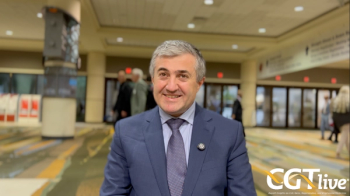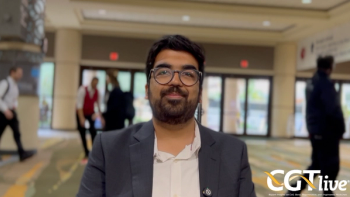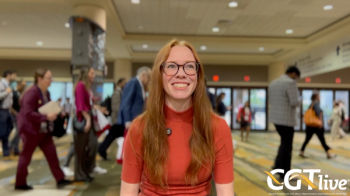
CAR T-Cell Response Rate Tops 80% in NHL Trial
Results of a phase II trial showed that more than 80% of patients with refractory non-Hodgkin lymphoma achieved objective responses to treatment with the chimeric antigen receptor (CAR) T-cell therapy axicabtagene ciloleucel.
Frederick L. Locke, MD
More than 80% of patients with refractory non-Hodgkin lymphoma (NHL) achieved objective responses to treatment with the chimeric antigen receptor (CAR) T-cell therapy axicabtagene ciloleucel (KTE-C19), results of a pivotal phase II trial showed.1
The 82% objective response rate (ORR) in 101 patients included complete responses (CRs) in 54% of patients. In general, responses were durable, persisting for a median 8.2 months, according to findings for the ZUMA-1 trial reported at the 2017 AACR Annual Meeting.
The patients had a median progression-free survival of 5.9 months. Among patients who achieved objective responses, the median overall survival (OS) had yet to be reached after a median follow-up of 8.7 months.
“This is the first pivotal trial of anti-CD19 CAR T-cells in refractory, aggressive non-Hodgkin lymphoma, and the results demonstrated a significant benefit for patients lacking curative options,” co-lead investigator Frederick L. Locke, MD, said in presenting the data. “The complete response rate of 54% is about 7 times higher than the historic control rate of 8% in patients with refractory non-Hodgkin lymphoma.”
The results of the ZUMA-1 study have been submitted to the FDA to support a biologics license application for axicabtagene ciloleucel as a potential treatment for transplant-ineligible patients with relapsed or refractory aggressive NHL, according to Kite Pharma. The company, which has been developing the drug under a breakthrough therapy designation, anticipates launching axicabtagene ciloleucel this year if the application is successful.
Axicabtagene ciloleucel, also identified as Axi-cel, is developed by engineering the patient's T cells to express a CAR that targets the antigen CD19, a protein expressed on the cell surface of B-cell lymphomas and leukemias.
Locke said patients in the ZUMA-1 trial experienced durable benefit with manageable toxicities. “Response is ongoing in 44% of responding patients,” said Locke, a medical oncologist at Moffitt Cancer Center in Tampa, Florida. “Cytokine release syndrome [CRS] and neurologic events occurred in most patients but were generally reversible.”
An analysis of potential markers for clinical benefit for the therapy showed “consistent efficacy and safety across a broad range of CD4/CD8 ratios,” said Locke, who reported biomarker lysis in a second presentation at the conference.2 Objective response was associated with higher levels of anti-CD19 CAR T-cells.
Higher levels of anti-CD19 CAR T-cells also were associated with higher-grade neurologic events, but not CRS, both of which are common effects of CAR T-cell therapy. Increased production of cytokines and chemokines was associated with grade 3+ neurologic events and CRS, said Locke.
CAR T-cell therapy has evolved, in part, in response to a substantial unmet need in refractory, aggressive NHL. Outcomes in refractory NHL remain poor, as reflected in a recent meta-analysis that showed an overall response rate of 26% and a median OS of 6.6 months.
The ZUMA-1 findings that Locke reported involved 2 cohorts of patients with aggressive, refractory NHL. One cohort comprised patients with refractory diffuse large B-cell lymphoma (DLBCL, N = 72), and the second cohort (N = 20) included patients with refractory primary mediastinal B-cell lymphoma (PMBCL) or transformed follicular lymphoma (TFL).
Eligible patients had chemotherapy-refractory disease, defined as no response to the most recent chemotherapy regimen or relapse within 12 months after stem-cell transplant. Other eligibility criteria included prior treatment with an anti-CD20 antibody, exposure to an anthracycline, and ECOG performance status of 0-1.
The trial had a primary endpoint of ORR. Key secondary endpoints included duration of response, OS, safety, and levels of CAR T cells and cytokines.
Investigators at 22 sites enrolled 111 patients. No bridging therapy was allowed prior to conditioning, which consisted of cyclophosphamide 500 mg/m2 plus fludarabine 30 mg/m2, administered for 3 days. Subsequently, 101 patients received axicabtagene ciloleucel, administered once at a dose of 2 x 106 CAR+ cells/kg.
The trial had a CAR T-cell manufacturing success rate of 99%. The turnaround time from apheresis to delivery to the clinical site averaged 17 days, said Locke.
The primary analysis included 92 patients, and the intention-to-treat analysis included all 101 patients. The ITT population consisted of 77 patients with DLBCL and 24 with PMBCL/TFL. Locke said 78 patients qualified for the trial because their disease was refractory to second- or later-line therapy, and 21 had posttransplant relapse within 12 months.
The ITT analysis of the primary endpoint showed an ORR of 82% in the patients with DLBCL (CRs in 49%), 83% in the PMBCL/TFL cohort (71% CR), and 82% in all 101 patients.
“Responses to Axi-cel were consistent across all key covariates,” said Locke.
Both ORR and CR increased over time. At 6 months, the ITT population had an ORR of 41%, including CRs in 36%. The 6-month overall and CRs were 36% and 31% for the DLBCL cohort and 54% and 50%, respectively, for the PMBCL/TFL cohort.
The 8.2-month median duration of response was driven primarily by durable complete responses, as the median had yet to be reached. In contrast, the median duration of partial responses was 1.9 months.
Although the median OS had yet to be reached in responding patients, the lower limit of the confidence intervals was 10.5 months. The ITT population had a 6-month OS of 80%.
The most common grade 3 treatment-emergent adverse events were anemia (43%), neutropenia (39%), decreased neutrophil count (32%), febrile neutropenia (31%), decreased white cell count (29%), thrombocytopenia (24%), encephalopathy (21%), and decreased lymphocyte count (20%).
Grade 3 CRS occurred in 18% of 62 patients included in an interim analysis and 13% of patients in the ITT analysis. The incidence of grade 3 neurologic events was 34% at the interim analysis and 28% at the final analysis. Three grade 5 (fatal) adverse events occurred during the trial, none after the interim analysis.
“All CRS events resolved except for one case of hemophagocytic lymphohistiocytosis and one case of cardiac arrest,” said Locke. “All neurologic events resolved except for 1 grade 1 memory impairment.”
Locke and colleagues performed an extensive analysis of potential immune signatures associated with response, with CRS, and with neurologic events. CRS is mediated by high levels of inflammatory cytokines, such as IL-6, he explained. Symptoms include fever, tachycardia, hypotension, and hypoxia. Neurologic events are associated with high CAR T-cell levels and/or high cytokine levels. Symptoms include confusion, tremor, aphasia, encephalopathy, and seizures.
The standard approach to managing CRS and neurologic events in patients treated with CAR T cells is administration of the IL-6 receptor antagonist tocilizumab and or corticosteroids. In the ZUMA-1 trial, 43% of patients received tocilizumab and 27% received corticosteroids.
Investigators performed the biomarker analysis on apheresis samples. A manufacturing success rate of 99% was achieved despite highly heterogeneous starting apheresis material, Locke noted.
Response, grade 3 CRS, and grade 3 neurologic events were evaluated by CD4/8 ratios. No consistent patterns were observed. The lowest ORR (68%) and CR (48%), as well as the highest incidence of grade 3 neurologic events, occurred among patients in the second quartile of CD4/8 ratio.
ORRs ranged from 83% to 92%, CR2 from 50% to 67%, and grade 3 neurologic events from 12% to 33% across the other 3 quartiles. The incidence of grade 3 CRS ranged from 12% to 17% across the CD4/8 ratio quartiles.
“CAR T-cell levels peaked within 7 to 14 days in patients treated with Axi-cel,” said Locke. “Expansion of CAR T-cells was associated with objective response and with grade 3 neurologic events.”
Several types of biomarkers were associated with both grade 3 CRS and grade 3 neurologic events: homeostatic, inflammatory, immune-modulating, chemokine, and effector.
Further analysis showed that peak levels of 3 biomarkers were associated only with neurologic events: IL-2, GM-CSF, and ferritin. The biomarkers were not associated with CRS.
Invited discussant Renier Brentjens, MD, PhD, chief of cellular therapeutics at Memorial Sloan Kettering Cancer Center in New York, said the durability of responses achieved with CAR T-cell therapy, as reported by several research groups, is particularly noteworthy.
“A remarkable number of patients have ongoing responses, and it is very encouraging,” said Brentjens, a pioneering CAR researcher. “We aspired to translation to a multicenter trial, like the ZUMA-1 trial, which involved a difficult population of patients with primary and relapsed aggressive B-cell malignancies. It was reasonably well tolerated, and what is significant is that the median overall survival was not reached in those patients who had responses.
“This ZUMA-1 trial was a major step forward, as a phase II multicenter trial that may allow for approval by the FDA as a commercializable drug,” Brentjens said.
References
- Locke FL, Neelapu SS, Bartlett NL, et al. Primary results from ZUMA-1: a pivotal trial of axicabtagene ciloleucel (Axi-cel; KTE-C19) in patients with refractory aggressive non-Hodgkin lymphoma (NHL). Presented at: 2017 AACR Annual Meeting; April 1-5, 2017; Washington, DC. Abstract CT019.
- Locke FL, Rossi J, Xue A, et al. Immune signatures of cytokine release syndrome and neurologic events in a multicenter registrational trial (ZUMA-1) in subjects with refractory diffuse large B cell lymphoma treated with axicabtagene ciloleucel (KTE-C19). Presented at: 2017 AACR Annual Meeting; April 1-5, 2017; Washington, DC. Abstract CT020.
<<<
Newsletter
Stay at the forefront of cutting-edge science with CGT—your direct line to expert insights, breakthrough data, and real-time coverage of the latest advancements in cell and gene therapy.

















































